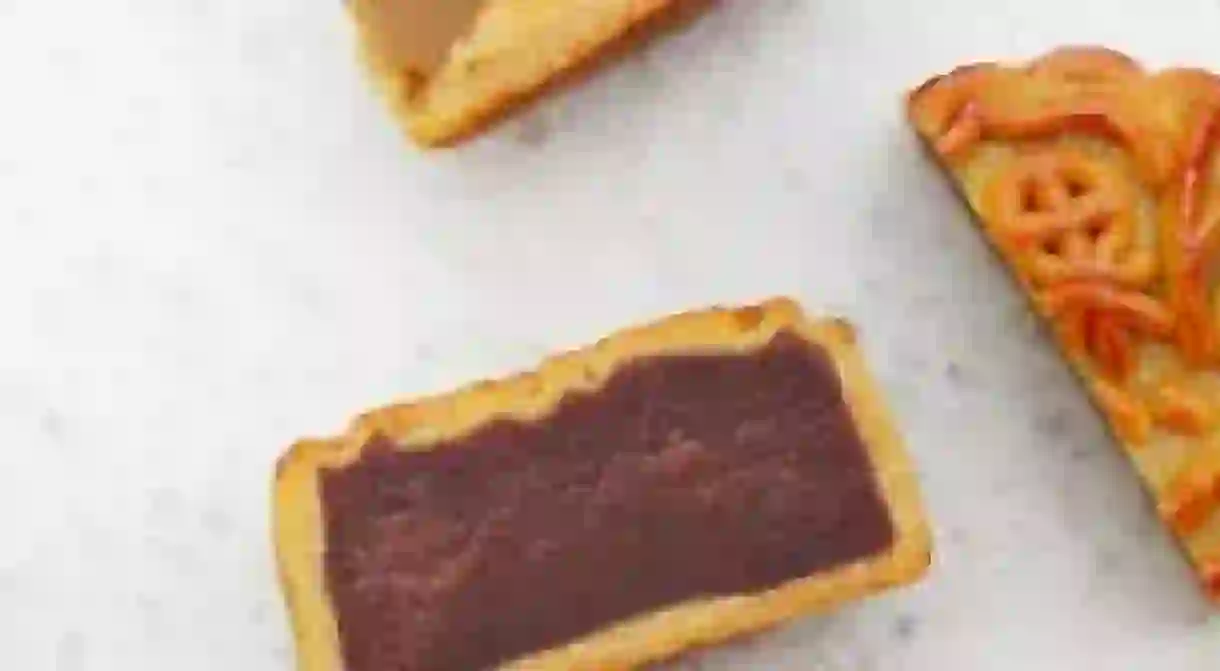Demystifying Mooncakes In China

Anyone not living under a rock in Shanghai may have noticed loads of beautifully molded pastries in many international chains, independent bakeries, larger supermarkets and convenience stores over the last couple of months. This might have sparked an interest in these mysterious little bundles of cake. What are they? What’s inside of them? What do they taste like? What are they made of? Here, we have the answers for you.

Mooncakes, or yuè bĭng (月餅), are eaten around the Mid-Autumn Festival in China, a week-long national holiday that usually takes place in October. They’re often given as gifts to family, friends or business associates around this time. They’re small baked cakes with a thin pastry shell, traditionally hand-crafted and filled with a very dense red bean or lotus seed paste and imprinted with various symbols.
Legend has it that mooncakes were used during the Ming Revolution to smuggle messages used to overthrow the Mongolians who were ruling China at the end of the Yuan dynasty. Rumors were started about a devastating plague that was spreading across the land, and the only way to cure it was by eating mooncakes. As terror spread so did the popularity of these small round pastries, which were said to have healing properties when, in fact, they contained hidden messages orchestrating the Han Chinese revolt on the 15th day of the 8th lunar month.
Hundreds of years later, chains such as Starbucks and Haagen Dazs have somewhat commercialized the ancient concept by launching their own ranges, which are quite different by comparison. Flavors such as ‘Osmanthus Cranberry,’ ‘Hazelnut Latte,’ ‘Caramel Macchiato’ and ‘Lychee and Raspberry’ are a far cry from traditional flavors like date, lotus seed, or seed and nut paste. Haagen Dazs went one step further and replaced their filling with ice cream, covering them in chocolate instead of pastry. There are even mochi-covered mooncakes or chocolate mooncakes, which are usually frowned upon by purists. These deviations are also said to have pushed the price of mooncakes up over the last few years, with talks of a ‘mooncake bubble’ having developed in China.
Here are some guidelines with regards to the more traditional fillings:
Creamy Custard — Those new to mooncakes will probably want to give this one a try first as it could be considered a ‘safer’ option in terms of flavor familiarity. It’s very sweet and incredibly rich, as one would expect from a custard, although the filling itself isn’t as creamy.
Lotus Seed Paste with Egg Yolk — Apparently the most traditional of fillings, lotus seed paste is also the most expensive. It is also often paired with a salty egg yolk center which symbolized the moon. It’s an acquired taste, quite savory and salty.
Fragrant Ham with Five Kernels — An interesting combination of flavors, including candied ham and a combination of five coarsely chopped nuts and seeds (anything from almonds, watermelon seeds, peanuts, walnuts, sesame seeds, pumpkin seeds, etc.) The texture is chewy but crunchy and probably not a favorite of most mooncake rookies.
Red Bean Paste — Used in many Chinese desserts, red bean paste is made from Azuki beans. A gorgeous color, it’s a very thick filling that tastes somewhat like sweet potato.
Shredded Coconut — Another ‘safe’ option, the flavor and texture of this mooncake is exactly what it says it is. If you like coconut, you’ll probably really enjoy this variant.

Mooncakes are incredibly dense and very rich, which explains why they’re usually cut into 4 parts and shared between family and friends. Another explanation for this dates back to the legend of the hidden messages, as it’s said that the symbols which were imprinted on the top of them were also hidden codes, only decipherable by cutting them into fours and using the pieces to decode a secret puzzle.
If you’re living in China, or have Chinese friends, definitely give them a try and decide for yourself which flavors you like the most and which ones you’re likely to avoid in the future. They make lovely gifts and are a very important part of the Mid-Autumn Festival, one of the four most important festivals in China.













